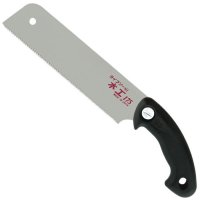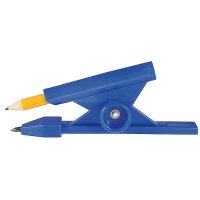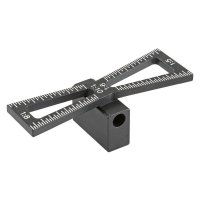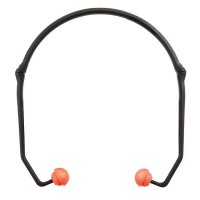Often, it's the simple things that make everyday life in the workshop easier. Some tools are almost indispensable and »worth their weight in gold« yet cost very little. In this blog post, we introduce you to affordable tools and explain why you should have them in your workshop.
Belongs in every tool bag
Surely this is a familiar scenario: You're asked by friends if you can 'quickly' fix something, hang a picture, or help with a move. In such cases, many reach for their tool bag or toolbox, hoping that all the potentially needed tools are contained within. The following affordable tools are perfectly suited for such tasks.
Japanese saw for the tool bag
A high-quality Japanese saw, used for precise wood joints, is not something one would like to take to a construction site or for installation work. The conditions there are rougher than in the workshop. The Kataba Mini by Z-Saw is a simple and affordable universal saw for fine cuts, trimming mouldings, and ideally suited for use in a mitre box (also available as a set). Its ergonomically shaped handle made of robust plastic is impervious to moisture and dirt. If necessary, a Replacement Blade is available for this affordable Japanese saw.

The Z-Saw Kataba Mini is versatile and fits perfectly into this saw guide
Drilling without electricity
They are lightweight, easy to use and versatile. This Auger Gimlet Set includes seven hand drills with diameters from 2.0 to 5.0 mm, suitable for pre-drilling nails and screws, as well as serving as a provisional clothes hook, assembly aid, or for crafting with children. The drills pull well into the material thanks to their fine screw tips and the deep groove ensures proper chip ejection.
Lifesaver
(Note: Work on electrical installations should only be carried out by trained professionals!) Anyone who has ever had an electric shock knows what this is about! The labelling on the fuse box was incorrect and - believing that there is no current - you unscrew an outlet or connect a ceiling lamp... With a Voltage Tester, you're on the safe side. This small screwdriver has an integrated phase tester for detecting alternating voltages in the low-voltage range.
For better control
Many tasks require well-controlled movements. For instance, when it comes to opening and closing screws with precisely measured force, fine-tuning wood joints, or smoothing surfaces, the following tools will be helpful.
For tightening, opening and clamping
With the DICTUM Chip Breaker Screwdriver, you can loosen and tighten the screw holding the chip breaker or cap iron on planes with less effort. The blade cross-section is adapted to the slightly larger screw slots of most planes for optimal force transmission. The short, compact handle allows good movement control, thus ensuring higher work safety. This screwdriver is also ideal for tightening and opening the Double Jaw Honing Guide when sharpening chisels and plane blades.

Fits perfectly into the slot of the screw holding the chip breaker
Compact for more control
For chiselling work, tradesmen usually have a set of chisels in different widths. These are typically long chisels with a robust ferrule on the handle so they can be struck with a hammer or mallet. However, when it comes to precisely fitting the parts of a wood joint, short paring chisels offer more control. Therefore, we also offer DICTUM® Chisels in short design. Its shortened handle with rounded end is comfortable to hold, while the shorter blade allows precise guidance close to the workpiece.
Planes without body
Scraper blades are often underestimated. Yet, they are ideal tools for surface finishing, removing stains in wood, and stripping old layers of paint or varnish. If a French Scraper Blade is sharpened correctly, it removes fine shavings like a plane. Even better, with a scraper you can work against or across the wood fibres, for instance, to remove small tear-outs in an already planed surface.
Small but nice
Small and flexible
A classic folding rule is often too large and too imprecise for marking wood joints. Small, semi-rigid rulers such as the Shinwa »Pickup« Precision Rule are much more accurate than a pocket rule and are easier to set up and align due to their compactness. The scales start exactly at the outer edge, making it easy to measure recesses and clearances even on small objects (e.g. boxes and turned objects).
Small and right-angled
The Japanese Mini Try Square is just as small and precise. It is significantly lighter than a classic carpenter's square and can be applied more easily and accurately, for example when transferring angles for dovetail joints or marking rows of holes. It is completely made of metal and fits into even the smallest of toolboxes.
Small and sharp
In comparison with a pencil or ink, scribing with a Hattori Marking Knife is more accurate and more durable, the marks are fine as a hair and do not smudge. In addition, the blade can be inserted directly into the mark when chiselling. The already cut wood fibres reduce tear-out during sawing.
Affordable specialists
Some tools perform very specific tasks. They may not be needed often, but when it comes down to it, you're glad to have them. For instance, the Parallel Marker, which is optimised for scribing installations, clearances, door cases, etc. While guiding the wide support leg along the reference surface, the pencil draws a marking line at the chosen distance. This allows you to shorten chair and table legs to exactly the same length. Thanks to the metal tip on the leg, the parallel marker can also be used as a simple compass.
For pins and tails
Traditionally, the pin angle is marked with a sliding bevel. This is set to a specific pitch ratio, for example 1:6 for softwood and 1:8 for hardwood. The affordable Dovetail Marking Jig offers four pitch ratios (1:5, 1:6, 1:8 and 1:10) simultaneously on the inside and outside of its legs, without any adjustment!
Exciting tools
In many situations, a »third hand« would be very helpful, for example when glueing a larger piece of furniture. In such cases, both the cauls and the clamps need to be positioned correctly. With simple spring clamps, such as the Pony Gorilla Clamps, you can attach the cauls to the body and have your hands free to set the clamps. The Pony »Protection« One-handed Spring Clamp provides enough contact pressure to glue mouldings in boat building, temporarily fix substructures and much more. You can never have enough spring clamps.

Keep mouldings and blocks in place - Gorilla Clamps
Delicate clamping
For fine clamping tasks such as attaching decorative mouldings or restoring old furniture, Klemmsia Clamps are ideal. These lightweight clamps with white oak arms can be delicately operated via an eccentric lever, and the pressure surfaces are equipped with workpiece-friendly cork pads. Smaller objects and wood joints can also be glued without cauls.
For your health
Finally, let's talk about tools to ensure your hearing and vision remain intact. We all have only one pair of ears and one pair of eyes and we should treat them well. With Safety Goggles you can prevent flying splinters, chips or sparks from getting into your eyes when milling, grinding or chiselling.
Large earmuffs provide optimal noise protection when working with machines but can become bothersome and annoying over the course of the day. Banded Earplugs, on the other hand, are small and light, so that they can be easily hung around your neck without getting in the way when not in use. Folded up, they fit comfortably in your pocket. This leaves no excuse for not adequately protecting your ears.








